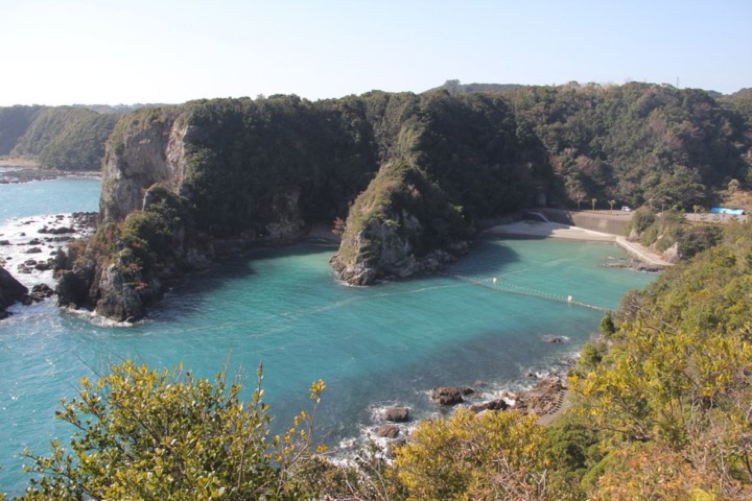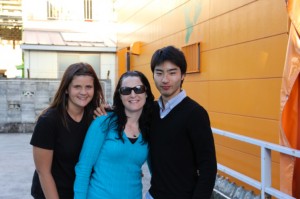Marine Life & Conservation
The Dolphin’s Cry

Sometimes, the sound of dolphin cries wakes me in the night. That sound haunts me, and I have no doubt that it will remain with me until my dying day. But remaining with it is the knowledge that I diplomatically worked with, and lived amongst, local villagers in a foreign land to educate and potentially stop those dolphin cries.
I don’t remember the first time I saw the Academy Award winning documentary, The Cove, or the first time I heard of the annual dolphin slaughter that happens in that natural finger of water along the Japanese coastline. It seems to have simply always been known to me; to have always been a part of my soul. But I never thought that I would go there; never thought I would witness the slaughter with my own eyes or hear the dolphin cries with my own ears. Yet in November 2010, I found myself standing on the rocky shore of the Cove in Taiji, Japan, gazing out over the water of that small bay, watching dolphins thrash in utter panic and then float still as their blood colored the Cove red.
My Call-to-Action came when the Sea Shepherd Conservation Society asked me to serve as their Cove Guardian Campaign Leader on the ground at the Cove in Taiji, Japan. My initial response was to turn down this offer because I was set in my life in Seattle, Washington State. I didn’t think it was a possibility for me to leave my full-time photography career, my husband, our animals and our life in general in order to spend four months in Asia. But I longed to accept this offer, to board a plane to Japan, to stand up for my beliefs, to live my passion for active marine conservation. It broke my heart to turn my back on my dream when it was finally being presented to me.
Life continued on as usual and each time I punched the time clock like a drone, the light in my soul was extinguished a bit more. It finally took some words of wisdom from a friend and co-worker to make me fully comprehend what I had just turned down. It’s not often, it’s extremely rare actually, that we get the chance to become what we have always dreamed of becoming. This was my chance. I accepted Sea Shepherd’s offer and found myself jobless, husbandless and on a plane destined for a country I had never thought twice about until that very moment. I was going to live in Japan for four months. I was going to work at the infamous Cove where I would actively participate in marine conservation. I had been chasing this dream since I was a tiny child and announced to my second grade teacher that I was going to save every dolphin and whale in the ocean, and here I was flying toward that dream. I suppose I should have been terrified, and while I was nervous and apprehensive, never once was I scared because I knew that this was what I was born for. I had no doubt then, and no doubt now, that I made the right decision when I left my ‘American Dream’ behind and ran, with my flags unfurled, toward my destiny.
Arriving in Japan was surreal and being at the Cove was something that words can never define. For the first time in my life, I was surrounded by like-minded individuals who completely understood, admired and respected my decision to radically change my life in order to come watch dolphins die. But it was so much more than that; each and every one of us was standing, conscious and present, bearing witness to the tragedy that takes place in that beautiful corner of the earth, so that we could serve as the voice of the voiceless; a conduit so the world could hear the dolphin’s cry. We were the only hope those sentient beings had for raising awareness towards the heartbreaking slaughter. Every September through March, volunteers flock to the Cove in the hopes of spreading the word and making a difference.
Since my departure from Japan in early 2011, I’ve joined Ric O’Barry and his organization, Save Japan Dolphins, and have founded my own group, Blue Ocean Foundation. Both of these groups put heavy stock into the education aspect of conservation and take a diplomatic approach to their presence at the Cove. Working with the local people, including the men who hunt the dolphins, is a major focus of time spent in Japan. In addition, speaking to schools in the Seattle area and hosting education-awareness events has become a way for me to spread the word during my time at home.
The Cove forever changed me. I sacrificed a great deal in order to pursue my passions, but I gained so much more and never once have I regretted the choice I made to stand on that beach. The slaughter is harrowing, haunting, disturbing, disgraceful and horribly, horribly tragic, but I, and the vast majority of people who have stood vigil at the Cove as well, feel that it would be even more tragic for those dolphins to die alone, with no one to remember them and no one to spread the word about their deaths.
Life is too precious to live the way someone else says you should. Never, ever be afraid to follow your dreams, to stand up for what you believe in and to be your true self.
Spread the word. Raise awareness. Speak out.
For more information about the Cove, watch the Academy Award winning documentary of the same title. You can also visit the websites for Save Japan Dolphins and Blue Ocean Foundation.
Blue Ocean Foundation: http://blueoceanfoundation.blogspot.com/
Save Japan Dolphins: http://www.savejapandolphins.org/
Blogs
Invitation from The Ocean Cleanup for San Francisco port call

6 years ago, The Ocean Cleanup set sail for the Great Pacific Garbage Patch with one goal: to develop the technology to be able to relegate the patch to the history books. On 6 September 2024, The Ocean Cleanup fleet returns to San Francisco bringing with it System 03 to announce the next phase of the cleanup of the Great Pacific Garbage Patch and to offer you a chance to view our cleanup system up-close and personal.
We look forward to seeing you there.
To confirm your presence, please RSVP to press@theoceancleanup.com
PROGRAM
Join The Ocean Cleanup as our two iconic ships and the extraction System 03 return to San Francisco, 6 years and over 100 extractions after we set sail, to create and validate the technology needed to rid the oceans of plastic.
Our founder and CEO, Boyan Slat, will announce the next steps for the cleanup of the Great Pacific Garbage Patch. Giving you a chance to view our cleanup system and the plastic extracted.
Hear important news on what’s next in the mission of The Ocean Cleanup as it seeks to make its mission of ridding the world’s oceans of plastic an achievable and realistic goal.
Interviews and vessel tours are available on request.
PRACTICALITIES
Date: September 6, 2024
Press conference: 12 pm (noon)
Location: The Exploratorium (Google Maps)
Pier 15 (Embarcadero at Green Street), San Francisco, CA
Parking: Visit The Exploratorium’s website for details.
RSVP: press@theoceancleanup.com
Video & photo material from several viewing spots around the bay
We look forward to seeing you there!
ABOUT THE OCEAN CLEANUP
The Ocean Cleanup is an international non-profit that develops and scales technologies to rid the world’s oceans of plastic. They aim to achieve this goal through a dual strategy: intercepting in rivers to stop the flow and cleaning up what has already accumulated in the ocean. For the latter, The Ocean Cleanup develops and deploys large-scale systems to efficiently concentrate the plastic for periodic removal. This plastic is tracked and traced to certify claims of origin when recycling it into new products. To curb the tide via rivers, The Ocean Cleanup has developed Interceptor™ Solutions to halt and extract riverine plastic before it reaches the ocean. As of June 2024, the non-profit has collected over 12 million kilograms (26.4 million pounds) of plastic from aquatic ecosystems around the world. Founded in 2013 by Boyan Slat, The Ocean Cleanup now employs a broadly multi-disciplined team of approximately 140. The foundation is headquartered in Rotterdam, the Netherlands, and opened its first regional office in Kuala Lumpur, Malaysia, in 2023.
Find out more about The Ocean Cleanup at www.theoceancleanup.com.
Marine Life & Conservation
SHARK MONTH ARRIVES AT ROYAL WILLIAM YARD, PLYMOUTH

A shark has been spotted approaching Royal William Yard in Plymouth, much to the surprise of swimmers, paddleboarders and onlookers.
With its distinctive dorsal fin cutting through the water, the sizeable shark swam along the coastline, before turning to head inland towards Firestone Arch at Royal William Yard. The appearance drew a crowd, who were captivated for more than an hour by the unusual sight – and it was all caught on video.
The shark is one of many expected sightings at Royal William Yard over the coming weeks… because today marks the start of Shark Month!
In reality, the ‘shark’ spotted along the Plymouth shoreline was actually a custom-made model, created by the team at Royal William Yard and sailed underwater by Caroline Robertson‑Brown from the Shark Trust, who donned scuba diving gear for the occasion.
The stunt took place to launch Shark Month in style and draw attention to the work of the leading international conservation charity, which is based in Britain’s Ocean City. Spectators were reassured that the water was safe and many entered into the spirit of the performance, swimming or sailing alongside the shark.
Shark Month will take place across Royal William Yard throughout July and will feature an extravaganza of art, entertainment and advocacy for everyone to enjoy. The packed programme of events starts with an art exhibition and ends with a trip on paddleboards with shark experts – with everything from a shark quiz to a Jaws screening in between.
Paul Cox, CEO of the Shark Trust, said: “There are often assumptions and misconceptions when it comes to sharks. This was certainly the case with the shark spotted at Royal William Yard! While the British coastline is home to many species of shark, this was not one of them. However, we’re thrilled it caught people’s attention, because seeing a shark is a special and memorable moment. That is precisely why we want to celebrate these incredible creatures, highlight the need for conservation, and ask for help to safeguard their future.”
For more information about Shark Month at Royal William Yard, visit the Shark Trust Website.
Images and video: Jay Stone
-

 Blogs2 months ago
Blogs2 months agoDiving With… Nico, Ocean Earth Travels, Indonesia
-

 News1 month ago
News1 month agoMurex Bangka Announce New Oceanfront Cottages & Beachfront Dining
-

 Blogs2 months ago
Blogs2 months agoA new idea in freediving from RAID
-

 Marine Life & Conservation1 month ago
Marine Life & Conservation1 month agoIceland issue millionaire whale hunter a licence to murder 128 vulnerable fin whales
-

 Marine Life & Conservation2 months ago
Marine Life & Conservation2 months agoThe Shark Trust Great Shark Snapshot is back
-

 News3 months ago
News3 months agoCharting New Waters; NovoScuba Goes Global with the Launch of their Revolutionary Dive Training Agency!
-

 Gear News1 month ago
Gear News1 month agoNew Suunto Ocean – a dive computer and GPS sports watch in one for adventures below and above the surface
-

 Marine Life & Conservation Blogs2 months ago
Marine Life & Conservation Blogs2 months agoBook Review: Plankton





